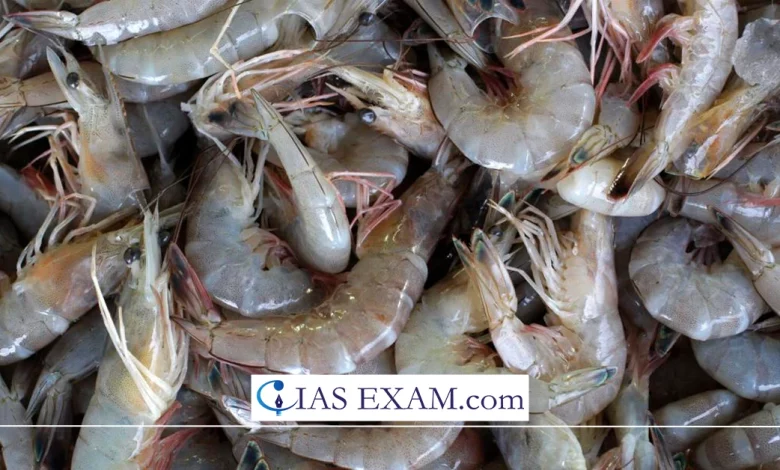India refutes shrimp farm abuse allegations
Syllabus: Indian Economy [GS Paper-3]

Context
Recent allegations of human rights and environmental abuses in the Indian shrimp industry have been brought to light by a report from the Corporate Accountability Lab (CAL). The report claims that workers in some shrimp hatcheries and peeling sheds in India face ‘dangerous and abusive conditions’.
Details
The Allegations
- The CAL report alleges that workers, particularly women, in the Indian shrimp industry are subjected to long hours, unsafe and unsanitary working conditions.
- It also raises concerns about the environmental impact of shrimp farming on local communities, particularly in Andhra Pradesh.
India’s Refutation
- The Indian government and the industrial officials have denied these accusations saying that the products they are exporting are of the highest international standards.
- They have claimed the shrimp commodity chain was certified by the Marine Products Export Development Authority (MPEDA) and that it met the global standards which, in turn, nullified the concerns raised by the Compliance Advisor Ombudsman (CAO) report.
Industry’s Economic Impact
- India has the size of the top global exporters of shrimp, entered the market of the US and has been showing a rising percentage.
- Number of seafood India’s exports was 8.09 billion dollars in the year of 2022-23 and out of which shrimps exported accounted for $5.6 billion.
Measures Taken
- The Commerce Ministry officials have scheduled a meeting with seafood exporters to debate about the matters and the industry’s global public image.
- The Ministry might recommend for exporters to hire independent auditors that will study the shrimping conditions e.g. labour conditions.
Regulatory Oversight
- The Indian shrimp industry is subject to regular monitoring by regulatory agencies, including inspections by the USFDA, European Commission, and the GAC of China, ensuring compliance with international regulations.
Shrimp
- Shrimp, the smallest species of decapod crustaceans, belong to the orders of Caridea and Stenopodidea. These are crustaceans found in almost all freshwater and saltwater environments, the world over, and have a delicate flavour that is greatly valued. They are beloved in cuisines around the globe.
- They are among the most adaptable species and can be discovered in trophic to temperature water. Shrimps perform a perturb function in marine ecosystems since it feeds on planktons and algae, as well as other marine organisms. It is in turn consumed by the larger fish, birds and marine animals.
- They are traded for the sake of their tasty meat which you can process in many different ways. For instance, you can grill, boil, fry and steam them.
- In terms of commercial activities, prawn is one of the major seafood products which are grown in many countries like India, Thailand, Vietnam and Ecuador with high scale farming operations which plays an important role for their economies.
- But another side of the coin is that environmental sustainability and the working conditions are the longtime topics of discussion and many wanted to see governments regulating and factories or workshops adopting better practices in the industry.
Shrimp Production in India
- India is among leading countries in the production and export of shrimps, and this is owing to its sociable climate, lengthy coast line and plentiful fresh water sources.
- The country primarily cultivates two main species: black tiger shrimp and whiteleg shrimp being the popular ones among them with whiteleg shrimp remaining popular because of its faster growth rate and the high yields of it.
- Shrimp farming happens mainly in the coastal states with Andhra Pradesh, Tamil Nadu, Gujarat, Odisha, and West Bengal being the major players in the field.
- Technological, infrastructural and Aquaculture advancements are known to lead to the completion of the fishing industry.
- Despite the fact that there are obstacles such as disease outbreaks, environmental issues, labour rights and social sustainability, progress in this area is still hampered.
- However, these challenges notwithstanding, shrimp production in India is still a very critical sector with many benefits as it has a high employment level and it in turn supports the livelihood of coastal dwellers.
Conclusion
The Indian government’s dismissal of the allegations is a strong statement of the country’s commitment to maintaining ethical practices in its shrimp industry. The response highlights the importance of regulatory compliance and the need for transparency in addressing such concerns.
Source: The Hindu
UPSC Mains Practice Question
Q.Describe the main challenges and opportunities associated with shrimp farming in India. In your response, discuss the factors contributing to the growth of the shrimp farming industry, major species cultivated, farming practices employed, and the socio-economic and environmental implications.





.png)



